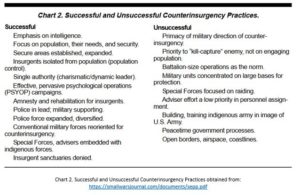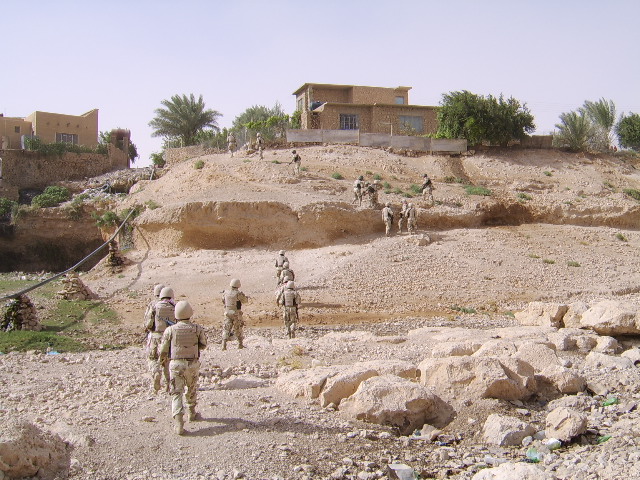The plan for this book review space is to provide a more detailed discussion on a specific book or in this case paper than a review. If we are reading a book, I would like to discuss it chapter by chapter to better understand the content. That way we can try to note particular things that are either relevant or and emphasize aspects to make them applicable to the working environment today.
For to today’s book review we are actually going to look at a paper, Best Practices in Counterinsurgency, published in June 2005 and written by Dr. Kalev I. Sepp. His entire bio can be found here.
Dr. Kalev I. Sepp is presently Senior Lecturer in Defense Analysis at the U.S. Naval Postgraduate School in Monterey, California. He teaches graduate courses in special operations, strategy, and irregular warfare to officers from the U.S. Army Rangers and Special Forces, U.S. Navy SEALs, U.S. Air Force, U.S. Marine Corps and allied special mission units. He lectures on security issues at national defense universities in the United States, Canada, Europe, and the Middle East.
Sepp, a former Green Beret and Harvard Graduate, also co-authored, Weapon of Choice: U.S. Army Special Operations in Afghanistan, (2003) and chapters for Assessment of War (2015), War in Iraq: Planning and Execution (2007), Leadership: The Warrior’s Art (2001).
Since Best Practices in Counterinsurgency was published in the Military Review in 2005, we can look back and see what was and was not implemented during the Iraq war and in Afghanistan. Given the timing of this publication and Sepp’s status of the one of the most influential counterinsurgency thinkers, this paper had an impact on the planning and execution of the wars for several years. The abstract:
We can discern best practices common to successful counterinsurgencies by studying the past century’s insurgent wars. Historical analysis helps us understand the nature and continuities of insurgencies over time and in various cultural, political, and geographic settings. While this does not produce a template solution to civil wars and insurrections, the sum of these experiences, judiciously and appropriately applied, might help Iraq defeat its insurgency. Nations on every continent have experienced or intervened in insurgencies. Not counting military coups and territorially defined civil wars, there are 17 insurgencies we can study closely and 36 others that include aspects we can consider. Assessment reveals which counterinsurgency practices were successful and which failed. A strategic victory does not validate all the victor’s operational and tactical methods or make them universally applicable, as America’s defeat in Vietnam and its success in El Salvador demonstrate. In both cases, learning more from one’s mistakes than one’s achievements is a valid axiom. If we were to combine all the successful operational practices from a century of counterinsurgent warfare, the summary would suggest a campaign outline to combat the insurgency in present-day Iraq.

According to Sepp successful operational practices should include at least these seven things, they include:
- Human Rights
- Law Enforcement
- Population Control
- Political Process
- Counterinsurgent Warfare
- Securing Borders
- Executive Authority
Reading this list, you can definitely see the surge strategy in Iraq taking shape. Interestingly, I don’t think we, the U.S., truly achieved many of these objectives in Iraq or Afghanistan. This is not a criticism of Sepp or his paper, just an observation that things have not gone as well as I think most of us hoped. Given the benefit of time, we can now see that the Law Enforcement and Political Process in both countries, Iraq and Afghanistan were corrupt (see here and here). Both governments have sought to elevate one group over another through graft or outright discrimination. In addition, the borders of both Iraq and Afghanistan were never closed tight enough to choke off the insurgency as evidenced here and here. On Executive Authority, the Taliban won’t even talk to the current Afghan Government and the FRONTLINE piece the Rise of ISIS demonstrates how weak, paranoid and insecure Malaki was creating the conditions for ISIS’s rise. On human rights, I agree that: “security of the people must be assured as a basic need, along with food, water, shelter, health care, and a means of living,” but freedom of worship, access to education, and equal rights for women, seem like Western Ideals not fully embraced in other places. That brings us to Sepp’s chart on what are Successful and Unsuccessful Counterinsurgencies.

Sepp states that:
Failed counterinsurgencies reveal unsuccessful operational practices….
And finishes with…
Disengagement from an unresolved counterinsurgency can doom an indigenous government. When the United States and the Soviet Union withdrew their forces from Vietnam and Afghanistan, the remaining indigenous governments were not vigorous or competent enough to maintain themselves with-out significant assistance. After the Soviet regime in Moscow fell, the Taliban readily deposed the pup-pet government in Kabul. In Vietnam, the U.S. Congress sharply curtailed military aid after the withdrawal of U.S. forces. With no other source of support, South Vietnam was vulnerable to the invasion from the North that deposed its regime.
I won’t advocate for a particular foreign policy; I don’t think that is what this space is designed for. I just wanted to put a really good and influential paper in-front of you to discuss its merits and short-comings of which in a perfect world, there are not many here. Implementing these practices has certainly been a challenge and a re-grounding in these principles will help in mission planning and mindset.

